| Srl | Item |
| 1 |
ID:
057631


|
|
|
| 2 |
ID:
080826
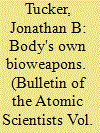

|
|
|
| 3 |
ID:
101793
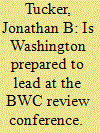

|
|
|
| 4 |
ID:
074631
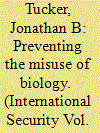

|
|
|
|
|
| Publication |
2006.
|
| Summary/Abstract |
Certain basic research ªndings in the life sciences have the potential for misuse by states or sophisticated terrorist organizations seeking to develop more lethal or effective biological weapons. The recognition of this problem has led to proposals for new systems of governance, including the international review and oversight of "dual-use" research. The case of the World Health Organization's Advisory Committee on Variola Virus Research (VAC), which oversees all research with the live smallpox virus, offers some useful lessons for assessing these proposals. This article examines how the VAC has dealt with contentious policy issues, describes the strengths and weaknesses of the oversight process, and discusses the implications for the international governance of dual-use research.
|
|
|
|
|
|
|
|
|
|
|
|
|
|
|
|
| 5 |
ID:
110764
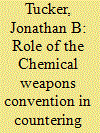

|
|
|
|
|
| Publication |
2012.
|
| Summary/Abstract |
A series of incidents over the past two decades has indicated that some terrorist groups are interested in acquiring and using improvised chemical devices (ICDs). Although the 1993 Chemical Weapons Convention (CWC) is a disarmament treaty that is legally binding only on sovereign states that join it voluntarily, the Convention fortuitously includes several provisions that can help its members to prevent chemical terrorism or to manage the consequences of an attack. This article examines the articles of the CWC that are relevant to counterterrorism and discusses how their implementation could be improved at the national and international levels. The article also addresses the role that the CWC secretariat, the Organization for the Prohibition of Chemical Weapons (OPCW) in The Hague, currently plays in preventing and responding to incidents of chemical terrorism, and the political factors that constrain its activities in the counterterrorism field.
|
|
|
|
|
|
|
|
|
|
|
|
|
|
|
|
| 6 |
ID:
091669
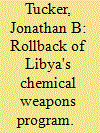

|
|
|
|
|
| Publication |
2009.
|
| Summary/Abstract |
In 2003, Libyan leader Muammar Qaddafi agreed to eliminate his country's weapons of mass destruction (WMD) programs and long-range Scud missiles under strict verification by U.S. and British experts and international inspectors. This article examines the negotiation and implementation of Libya's WMD rollback, with a primary focus on its chemical weapons program, and draws some lessons for the future. Although the Libyan case was unique in many ways, some aspects have relevance for other countries, including the critical role played by multilateral nonproliferation organizations, the utility of economic sanctions and export controls, the importance of a flexible U.S. disarmament funding mechanism, the value of rotating technical assistance teams in and out of the country that is disarming, and the desirability of remaining politically engaged with a former proliferator after rollback is complete
|
|
|
|
|
|
|
|
|
|
|
|
|
|
|
|
| 7 |
ID:
093421
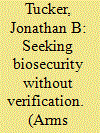

|
|
|
| 8 |
ID:
086464
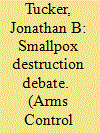

|
|
|
|
|
| Publication |
2009.
|
| Summary/Abstract |
One of the longest and most contentious international policy debates has swirled around the question of whether to destroy the last known stocks of the smallpox (variola) virus, which are preserved at two World Health Organization (WHO)-authorized repositories in Russia and the United States. Although smallpox was eradicated from nature more than three decades ago, concerns surfaced in the early 1990s that a few countries may have retained undeclared samples of the virus for biological warfare purposes. Because a smallpox outbreak would be a global public health emergency of major proportions, in 1999 the WHO approved a research program at the two authorized repositories to develop improved medical defenses against the disease.
|
|
|
|
|
|
|
|
|
|
|
|
|
|
|
|
| 9 |
ID:
096004
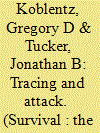

|
|
|
|
|
| Publication |
2010.
|
| Summary/Abstract |
On 18 September 2001, exactly one week after the 11 September terrorist attacks in the United States, five letters containing dry powdered spores of Bacillus anthracis - rugged, seed-like forms of the bacterium that causes anthrax - were mailed to media outlets in Florida and New York City. Three weeks later, two more letters containing a more refined preparation of anthrax spores were sent to US Senators Tom Daschle and Patrick Leahy in Washington DC. The tainted letters contaminated several buildings and caused 22 cases of anthrax (half involving the skin and half the lungs) in five states and the District of Columbia. Five of the people who contracted the inhalational form of anthrax died: two US Postal Service employees in Washington; an employee of American Media, Inc. in Boca Raton, Florida; a 94-year-old woman in Oxford, Connecticut; and a hospital worker in New York City. The anthrax letter attacks also had pervasive ripple effects, forcing thousands of people to take antibiotics as a precaution, disrupting the US Postal Service, temporarily shutting down the US Senate, causing nationwide anxiety about the safety of the mail, and triggering a flood of false alarms and hoaxes involving white powders. All told, the cost of the incident was estimated at $6 billion.
|
|
|
|
|
|
|
|
|
|
|
|
|
|
|
|
| 10 |
ID:
076217
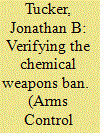

|
|
|
| 11 |
ID:
071392
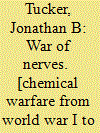

|
|
|
|
|
| Publication |
New York, PAntheon books, 2006.
|
| Description |
xi, 479p.
|
| Standard Number |
0375422293
|
|
|
|
|
|
|
|
|
|
|
|
Copies: C:1/I:0,R:0,Q:0
Circulation
| Accession# | Call# | Current Location | Status | Policy | Location |
| 051327 | 358.3409/TUC 051327 | Main | On Shelf | General | |
|
|
|
|
| 12 |
ID:
018960
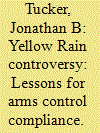

|
|
|
|
|
| Publication |
Spring 2001.
|
| Description |
25-42
|
|
|
|
|
|
|
|
|
|
|
|
|
|
|
|